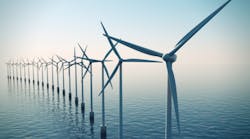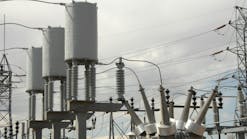Offshore wind power has been receiving a great deal of attention as a possible large source of future electric power. While Europe has been making major investments in this power source for years, the United States and New York are just now starting to focus on its potential. Later this year, America’s first offshore wind farm near Block Island, Rhode Island is expected to be operational, generating 30 megawatts of power.
On Sept. 15, the New York State Energy Research and Development Authority (NYSERDA) released a blueprint discussing New York’s available offshore wind energy. The blueprint is part of Governor Cuomo’s commitment to reduce carbon emissions by 40 percent and generate 50 percent of the electricity consumed in New York from renewable sources by 2030. A final plan for achieving this is expected by the end of 2017.
Harnessing Offshore Wind
On March 16, 2016 the U.S. Bureau of Ocean Energy Management identified a Wind Energy Area (WEA) 11 miles off the coast of Long Beach, New York.[i] On June 2, 2016, the Department of the Interior announced the proposed sale of this same WEA for a commercial wind farm.[ii] This federal policy established the foundation for New York to identify and promote offshore wind power.
NYSERDA has announced its participation in the lease auction. [iii] In an April 2016 cost analysis, NYSERDA identified 12 offshore New York locations which could generate up to 11,440 megawatts, enough power to generate over 3.6 million homes, with an estimated cost of $5.2 million a megawatt.[iv]
The NYSERDA blueprint found enormous potential for offshore wind power – 39 gigawatts of offshore wind energy, enough to power approximately 15 million homes.[v]
Challenges and Opposition
Like conventional, on-land sources of electricity, offshore wind energy faces challenges.
Offshore wind installation costs approximately twice as much as onshore wind farms. It also has additional costs, such as the need to update transmission infrastructure.[vi] With much of New York’s transmission infrastructure more than 30 years old, significant improvements are needed before introducing new power sources to the grid.
As an intermittent power source, wind on average only produces 30-35 percent of capacity.[vii] While NYSERDA’s maximum projection of 11,400 megawatts in energy generated from offshore wind is large, New York would receive less than 4,000 megawatts in offshore wind generation day to day. For perspective, New York has 39,039 megawatts of electricity generating capacity.[viii]
In addition to costs, transmission challenges, there are other large hurdles, including the following.
Not-in-my-Backyard (NIMBY) Opposition almost always occurs when large energy projects are proposed in New York. In fact, the strong local opposition in Massachusetts to the Cape Wind project may be indicative of the opposition that New York’s offshore wind projects could face.
Bird migratory and marine life issues will also be a concern, especially given the vast size of many offshore wind facilities.
Preserving sea lanes will be an important consideration, especially as New York’s economy thrives on trade, especially from ocean transport.
Financing challenges are also an issue with many large proposed energy infrastructure projects. Simply put, many are proposed and then withdrawn. Because of changing economics, and the delays and uncertainties in getting new projects built, many companies and investors withdraw these high-priced proposals.
While wind power can help in achieving clean energy goals, it is critical that we keep clean, baseload power on the grid to meet energy demands. With electricity demands, especially peak demands rising, New York will need to have many clean, non-emitting sources of carbon to achieve the State’s environmental goals.
About the Author:
Dr. Matthew C. Cordaro is the former CEO of the Midwest Independent System Operator, the non-profit transmission grid operator serving 15 states and a Canadian province. He serves on the advisory board of the New York Affordable Reliable Electricity Alliance (New York AREA), and is also a former CEO at utility companies.
ENDNOTES
[i] Bureau of Ocean Energy Management, “Announcement of Area Identification,” March 16, 2016. Item appears in second and fifth paragraphs. Retrieved on September 9, 2016. http://www.boem.gov/NY-Area-ID-Announcement/
[ii] U.S. Department of the Interior, “Interior Announced Milestone for New York Offshore Commercial Wind Energy,” June 2, 2016. Item appears in first and third paragraphs. Retrieved on September 9, 2016. https://www.doi.gov/pressreleases/interior-announces-milestone-new-york-offshore-commercial-wind-energy
[iii] New York State Energy and Research Development Authority, “New York State to Participate in Offshore Wind Lease Auction,” June 2, 2016. Item appears in first paragraph. Retrieved September 9, 2016. https://www.nyserda.ny.gov/About/Newsroom/2016-Announcements/2016-06-02-New-York-State-to-Participate-in-Offshore-Wind-Lease-Auction
[iv] Newsday, “NY readies release of wind-energy draft blueprint,” August 6, 2016. Item appears in sixth paragraph. Retrieved September 13, 2016. http://www.newsday.com/long-island/ny-readies-release-of-wind-energy-draft-blueprint-1.12144744
[v] New York State Energy Research and Development Authority, “Blueprint for the New York State Offshore Wind Master Plan,” September 15, 2016. Item is located on page four of pdf, second paragraph. Retrieved September 19, 2016. https://www.nyserda.ny.gov/offshorewind
[vi] International Renewable Energy Agency, “Renewable Energy Technologies: Cost Analysis Series – Wind Power,” June 2012. Item appears on pages 24 and 25 of pdf. Retrieved September 13, 2016. https://www.irena.org/documentdownloads/publications/re_technologies_cost_analysis-wind_power.pdf
[vii]Environmental and Energy Study Institute, “Renewable Energy Fact Sheet,” May 2006. Item appears in eighth paragraph. Retrieved September 9, 2016. http://www.eesi.org/files/wind_energy_0506.pdf
[viii] New York Independent System Operator, 2015 Power Trends Report. Item found on pages 5 and 22. Retrieved on September 22, 2016. http://www.nyiso.com/public/webdocs/media_room/press_releases/2015/Child_PowerTrends_2015/ptrends2015_FINAL.pdf


